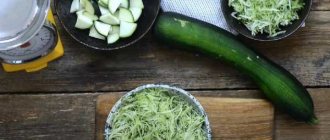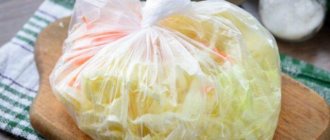Garlic is very good for health, and it is also indispensable in home cooking as a seasoning. The best garlic is the one grown on your own plot.
You can buy good garlic at the market from gardeners immediately after harvesting. But maintaining it until next season is not easy.
Over time, the cloves begin to dry out, oxidize or rot, and insects can infest them. To avoid this, many thrifty people freeze garlic in the freezer.
We will tell you later whether it is possible to freeze garlic for storage and how to do it correctly.
Is it allowed to be stored in the freezer?
Yes, garlic can be frozen. This is a great way to preserve as much as possible the substances it contains that make it aromatic, tasty and healthy. Freezing as one of the most effective methods of canning is used not only by housewives, but also by professional chefs.
The taste and aroma become slightly less pronounced after freezing. But the changes are almost invisible. The richness of garlic aroma and taste can be adjusted by slightly increasing its dosage.
Garlic does not lose its beneficial properties when frozen. If you prepare it correctly, freeze it, defrost it, it remains just as useful.
Its main medicinal functions:
- kills bacteria;
- speeds up metabolism;
- strengthens the immune system;
- prevents thrombosis;
- helps fight intestinal parasites.
Advantages and disadvantages
Housewives often use freezing garlic to store it. This method has both pros and cons. Namely:
pros:
- garlic retains antibacterial properties;
- retains useful microelements;
- lasts longer than any other method;
- ready to use immediately.
Minuses:
- loses a little aroma;
- the taste is not as pronounced as fresh;
- after defrosting, it loses its appearance and “creeps”.
The pros and cons overlap each other, as a result of which each housewife herself will evaluate the advisability of freezing garlic. An alternative could be a method of preserving garlic for the winter, such as drying it for seasoning using household appliances or fresh air.
Freezing methods
You can freeze it in several ways:
- Whole onions.
- Separately cleaned cloves.
- In the form of a paste.
The freezing option is chosen taking into account how the garlic will be used later.
When choosing to freeze onions or cloves, you need to take into account that after defrosting it will become soft and shapeless . No matter how hard you try, you won’t be able to use it as a juicy, crunchy ingredient, for example, in a salad.
Bulbs
Whole unpeeled heads of garlic are rarely frozen, since after defrosting it will be necessary to remove all the scales and partitions that stick to the softened cloves. Choose this method if you have no time to prepare before freezing.
This canning is done as follows:
- cut the stem as close as possible to the head;
- remove the top rough scales, leaving only a thin film;
- wrap each head tightly with cling film;
- place the bulbs wrapped in film in the freezer so that they do not touch each other;
- After a day, you can remove the frozen onions, collect them in a bag for compact storage, and quickly return them to the freezer.
With cloves
The cloves can also be frozen with the husk. But it is much more practical to peel them while they are still fresh, when they are hard and easily released from the shell.
Procedure for this freezing method:
- Clean the cloves thoroughly.
- Remove damaged slices.
- Pack several cloves into bags.
- Load into the freezer.
- Later, the already frozen bags can be collected into one large bag or container.
It is advisable to use bags with an airtight closure. It is better not to wrap it with film - it will be difficult to remove. In each individual bag you should put as many cloves as you usually use when preparing one dish.
There is another way to freeze garlic cloves:
- clean and sort out the slices;
- place them in bulk on a large board;
- After a day, collect and put in a common bag or container.
The second method requires more attention - you need to make sure that the cloves freeze quickly and do not touch on the board. Then, the already frozen slices will not stick together, and you can take as many cloves from the common package each time as you need to prepare a specific dish.
Garlic paste
Garlic can be ground in a blender, turning it into a paste, and then frozen. This method is the most labor-intensive. But it is more convenient to use the paste after defrosting - there is no need to clean and grind it. The paste is packaged in small bags, ice cube trays, or medium-sized packaging bags (distributing the crushed root vegetable in a layer).
Sequencing:
- Grind the peeled and selected garlic with a blender (you can grate it with a grater or pass it through a meat grinder).
- Distribute the paste into bags or molds.
- Place in the freezer.
- After a day, the frozen cubes can be removed from the bags and molds, transferred to one common container, and returned to the freezer (this must be done very quickly).
You can add the same chopped herbs to the chopped garlic mixture before freezing. These ingredients should be mixed in the proportions that you usually use for your dishes.
How to defrost?
When adding frozen garlic to hot dishes, defrosting is not required. You just need to take the required number of cloves or crushed mixture out of the freezer and add it during cooking. Under the influence of high temperature, the garlic will quickly thaw, its aroma and taste will instantly reveal. But this only applies to peeled garlic.
If whole onions were frozen, or garlic needs to be added to a cold dish (salad or appetizer), then before use it must be properly defrosted, and the onions must also be thoroughly cleaned.
Defrosting procedure:
- remove from the freezer and place on the refrigerator shelf;
- after a few hours it can be taken out and kept until completely thawed at room temperature;
- Peel the onions;
- chop the cloves;
- season the dish.
The garlic puree will be mixed with liquid after thawing. It can be drained or used for hot dishes.
When frozen, garlic can be stored until the next harvest. Maximum – one year. If it hasn't been used in a year, it's better to throw it away and make fresh supplies .
Thawed garlic, regardless of the freezing method, should be used within a maximum of 4 days. Then it will acquire an unpleasant odor.
Is it possible to freeze onions? Is it possible to freeze onions for the winter?
For different types of onions, the technology for preparing for freezing and general recommendations differ. Let's look at this in more detail.
Green
The feathers are separated from the head: wilted parts of the plant are not suitable for storage. The greens are thoroughly washed and dried: otherwise, when frozen, they will turn into an ice lump. It can be crushed if desired.
Bulb
The debate about whether to freeze onions remains relevant today. Some people believe that because of the smell, it should not be stored near any other foods. There is an opinion that a frozen “turnip” turns into a “glassy”, watery and soft mass.
The above troubles will not happen if you approach the process competently. Heads are selected without surface stains or signs of rot. The maximum cutting thickness is 1 cm. Store onions only in small portions, leaving a little free space in the bags, because the frozen product increases in volume.
Leek
This type of onion tastes much softer and sweeter, so freezing it brings less trouble. Some housewives are accustomed to throwing away the upper leaves of the plant due to its fibrous structure. However, they contain the maximum amount of useful substances.
After cleaning, the stems are cooled at a temperature of about 0°C. After a few hours, the leeks are put into plastic bags - no more than 8 pieces in one bag - and placed in the freezer.
Schnitt
This is an excellent seasoning for a wide variety of dishes. Before freezing, the chives are washed well and dried under natural conditions. Rubbing with a towel will damage the delicate feathers: this will cause the unique aroma to disappear.
Chop the product with a knife to the size you are used to using when preparing dishes. The slices in the bag are placed in a horizontal layer: this way the freezing will take place evenly.
Application
Frozen garlic is used like regular fresh garlic. Suitable for preparing any dishes:
- soups;
- salads;
- marinades;
- side dishes;
- pilaf;
- sauces;
- snacks.
In order for the garlic to combine evenly with the rest of the ingredients, it needs to be chopped. In some cases, you can add whole cloves (for example, to pilaf or marinades). But not everyone will like the soft, shapeless pieces in soups and salads.
Since the taste and smell of frozen root vegetables are slightly weaker, you need to add more of them than raw ones. But it’s important not to overdo it here. It is better to add garlic 2-3 grams (the size of an average clove), gradually bringing the dish to the desired taste and smell.
LiveInternetLiveInternet
—Categories
- Crochet toys (3256)
- Birds (239)
- Little people, house gnomes (187)
- Doggies (177)
- Sheep (143)
- Bunnies (135)
- Bears (115)
- Flowers, trees (114)
- Pussies (102)
- Balls, toys (99)
- Pigs (90)
- Keyrings (87)
- Mice (83)
- Monkeys (79)
- Insects (50)
- Chanterelles (38)
- Baby dragons (36)
- Horses (35)
- Fish (30)
- Frogs (27)
- Hedgehogs (25)
- Sea life (23)
- Elephants (23)
- For toys (22)
- Raccoons (20)
- Cows (20)
- Hippos (16)
- Rattles (15)
- Turtles (15)
- Deer (13)
- Lions, tigers (11)
- Wolves (11)
- Giraffes (10)
- From motives (10)
- Tigers (9)
- Crocodiles (9)
- Seals (6)
- Squirrels (5)
- Moles (5)
- Gloves (4)
- Snakes (4)
- Transport (4)
- Kangaroo (3)
- Trophies (2)
- Lizards (2)
- Sea life (1)
- Patterns (1709)
- Hook (527)
- Spokes (381)
- Irish lace (68)
- Cooking (925)
- Salad (228)
- Baking (218)
- Vegetables (136)
- Kura (98)
- Minced meat (78)
- Meat (52)
- Potatoes (37)
- Mushrooms (29)
- Fish (26)
- Sauces (19)
- Rice (13)
- Pasta (11)
- Liver (5)
- Microwave (4)
- websites (1)
- Change (825)
- Necessary stuff (127)
- Flowers (107)
- Applications (74)
- Potholders (44)
- Bookmarks (30)
- Baskets (12)
- Cases (8)
- Knitting (663)
- Health (496)
- Face (139)
- Trying to lose weight (105)
- Exercises (65)
- Vessels (63)
- Hair (57)
- Nails (40)
- Treatment (34)
- Hands (19)
- Legs (18)
- Cold (10)
- Eyes (8)
- Blankets, rugs (496)
- Lessons (424)
- Hook (108)
- Spokes (92)
- Children (424)
- Girls (215)
- Kids (159)
- Boys (64)
- Women's models (374)
- summer (113)
- autumn-winter (10)
- Schemes (272)
- Beads (235)
- Bags (185)
- For toys (167)
- Scarves (166)
- Slippers (159)
- C/U (151)
- Comfort (18)
- Flowers (15)
- Flowers, trees (6)
- Felt toys (113)
- Ideas (108)
- Cords (103)
- Beanies (91)
- English (84)
- Origami (78)
- Macrame (58)
- Kitties (57)
- Motif toys (56)
- Knitting toys (44)
- Pussies (8)
- Dogs (7)
- Birds (5)
- Bunnies (5)
- Monkeys (4)
- Mice (3)
- Hippos (2)
- Sheep (1)
- Magazines (42)
- Program (35)
- Links (34)
- For animals (33)
- Male models (33)
- Nylon toys (31)
- For school (30)
- Tunisian knitting (26)
- Gloves (15)
- Socks (13)
- Felts (11)
- Cartoons (4)
- Foamiran (3)
- Mitten toys (2)
- Nuking (1)
- Tests (1)
How to freeze eggplants for the winter
Other options
Alternative options:
- Salting.
- Drying.
- Pickling.
Dried garlic is convenient to store and use. But this is a rather complicated method of preparation. The garlic cloves must first be cut into thin slices and then dried in the oven for several hours. In this case, it may burn or not dry completely.
An option for drying garlic - in the video:
When pickling, garlic is covered with salt, a natural preservative. The salted root vegetable should be packaged in jars with airtight lids . You can pour the root vegetable with a salty solution and store it in a jar on the refrigerator shelf. In any case, containers with pickling take up a lot of space.
You can pickle garlic with the addition of vinegar, sugar, salt and various spices. This way it will retain its crispy texture. But the pickling procedure may be too complicated for those who do not like and do not know how to can their own vegetables.
How to cook spicy pickled garlic - on video:
Recommendations
You need to freeze garlic in August or early September, when it is still as fresh and juicy as possible . The longer it sits, the drier it will be, and the more it will lose its taste and aroma.
Garlic can be frozen along with herbs or as a sauce. Packing the preparations into portions for one dish. For example, you can make separate preparations for borscht, pilaf, and marinated meat.
In addition to garlic cloves, you can freeze garlic arrows. They are chopped or ground into a paste. The arrows are frozen separately, along with the cloves, with parsley and dill, or as a ready-made sauce with the addition of spices, butter, and cream.
Tips for freezing garlic
Choose the highest quality organic garlic you can find in the store. The fresher and better quality the garlic, the better it will retain its flavor after freezing. Garlic should be hard - this means it is fresh. Make sure there are no stains, green growth or mold.
After peeling and removing sprouts and stems, dry the garlic thoroughly. The absence of excess moisture helps preserve the fresh, strong flavor of garlic after freezing.
Use freezer safe, airtight containers as directed above. This not only helps maintain fresh taste and reduces the risk of packaging being damaged.
Vegetarians vs meat eaters. Who is better at sex?











